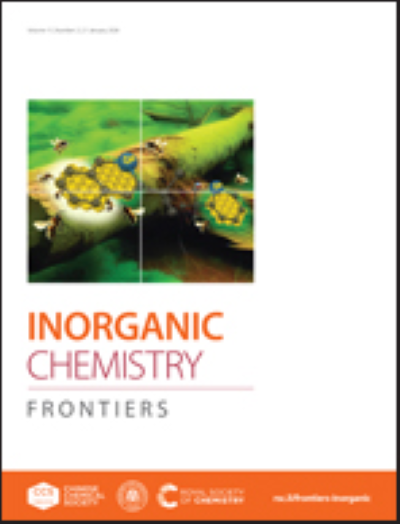Photoluminescence Enhancement of Mn4+-doped Rb2NaAlF6 Single-Crystal Phosphors via Heterovalent Co-doping for Wide Gamut Displays
IF 6.1
1区 化学
Q1 CHEMISTRY, INORGANIC & NUCLEAR
引用次数: 0
Abstract
Mn4+ activated fluorides are crucial for lighting and displays, owing to their unique narrowband red emission and broadband blue light excitation. However, designing target red phosphors that simultaneously possess appropriate chromaticity coordinates, short fluorescence lifetimes, and high quantum efficiencies (QEs) remains a significant challenge. Herein, by employing a synergistic strategy of the growth of single-crystal phosphors combined with a heterovalent co-doping approach, the shorter fluorescence lifetimes (4.93 ms), excellent chromaticity coordinates (0.7001, 0.2998), and high external QE (EQE, 50.91%) is first achieved in the Rb2NaAlF6:Mn4+, Mg2+ (RNAFMM-C) single-crystal red phosphor. The significant increase in EQE (from 13.19% to 50.91%) is attributed to the single-crystal morphology with rare defect and low surface energy, and the increased distortion of the [MnF6]2- octahedron, which breaks the partial parity-forbidden transition selection law. Additionally, the crystal samples RNAFMM-C exhibit superior moisture resistance. More importantly, combing the RNAFMM-C, commercial green phosphor 𝛽-Sialon and blue InGaN chip, an emitting device with high luminous efficiency of 118.48 lm W-1 and wide color gamut of 109.20% National Television Standards Committee (NTSC) is further demonstrated, which shows good potential in projector. The RNAFMM-C is a promising red-light component for the next generation of wide gamut displays.宽色域显示用Mn4+掺杂Rb2NaAlF6单晶荧光粉的异价共掺杂增强光致发光
Mn4+活化氟化物由于其独特的窄带红光发射和宽带蓝光激发,在照明和显示中至关重要。然而,设计同时具有合适的色度坐标、短荧光寿命和高量子效率(QEs)的目标红色荧光粉仍然是一个重大挑战。本文采用单晶荧光粉生长的协同策略与异价共掺杂相结合的方法,首次在Rb2NaAlF6:Mn4+, Mg2+ (RNAFMM-C)单晶红色荧光粉中获得了较短的荧光寿命(4.93 ms)、优异的色度坐标(0.7001,0.2998)和较高的外部QE (EQE, 50.91%)。EQE显著增加(从13.19%增加到50.91%),这主要是由于缺陷较少、表面能较低的单晶形貌,以及[MnF6]2-八面体畸变增加,打破了部分奇偶禁止的跃迁选择规律。此外,晶体样品RNAFMM-C表现出优异的抗湿性。更重要的是,结合RNAFMM-C、商用绿色荧光粉𝛽-Sialon和蓝色InGaN芯片,进一步演示了一种发光效率高达118.48 lm W-1,色域宽达109.20%的发射器件,在投影机中显示出良好的潜力。RNAFMM-C是下一代宽色域显示器的有前途的红光组件。
本文章由计算机程序翻译,如有差异,请以英文原文为准。
求助全文
约1分钟内获得全文
求助全文
来源期刊

Inorganic Chemistry Frontiers
CHEMISTRY, INORGANIC & NUCLEAR-
CiteScore
10.40
自引率
7.10%
发文量
587
审稿时长
1.2 months
期刊介绍:
The international, high quality journal for interdisciplinary research between inorganic chemistry and related subjects
 求助内容:
求助内容: 应助结果提醒方式:
应助结果提醒方式:


